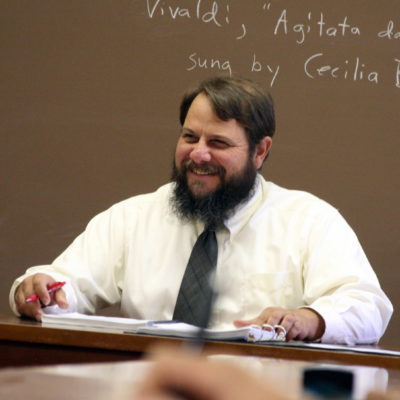"The power of the Good has taken refuge in the nature of the Beautiful."
-- Plato, Philebus
Fine Art Curriculum
The study of the fine arts is integral to our curriculum, teaching students that beauty is inseparable from truth, and helping them to recognize and appreciate transformative ideas that have found artistic expression throughout history. The Fine Arts track develops attentiveness to the many traces of beauty in great artistic achievements — from ancient times to the modern era — in such manifestations as sculpture and architecture; icons and paintings; songs and symphonies. The courses weave theological and philosophical reflection into this historical framework, helping students to recognize through great masterworks that the power of truth elevates all cultural activities.
In the Music curriculum, students are acquainted with the elements and language of music: rhythm and melody; modes and keys; forms, periods, and styles. They learn how pitch, harmony, and rhythm are rooted in the physical nature of sound; learn of the historical development of Western music through major composers and works, from the Middle Ages to the present; and receive a grounding in sacred music of the Catholic tradition. The curriculum combines lessons in theory, practical exercises, and frequent listening to music in its mission to develop an educated ear in our students. Such knowledge and experience are key steps in the journey from being a merely passive listener to an active, critical, and appreciative one.
In the Visual Arts curriculum, senior students devote a year to the painting, sculpture, and architecture of Europe and its historical development from ancient Greece to early Christian Rome; from Byzantium to the Latin Middle Ages; from the Florentine Renaissance through the Baroque era; as well as forays into the more recent past. In tandem with its musical counterpart, this sequence demonstrates how the intellectual or spiritual questions, problems, and ideas of each age take on concrete, visible, cultural expressions — expressions that form the souls of the people who view, use, and inhabit them.
Courses
Students begin the study of music with elements of music theory, including rhythms in simple and compound time signatures, pitch and melody, key signatures, the circle of fifths, scales and intervals. Led by the ancient Greeks, we discover the relationships between music, mathematics, nature, and the human soul. Then ensues the first half of a guided tour of western musical history, starting in the early Middle Ages, continuing through the Renaissance, and focusing, in the Baroque period, on the work of three great masters, Vivaldi, Bach, and Handel. Throughout, attention is given not only to great works of different composers but also to the overall development of musical styles. Observations touching the aesthetics, spirituality, and morality of music are also made, foreshadowing a central concern of the second semester.
| Boethius | Fundamentals of Music, Book I |
| Zuckerkandl | “The Two Concepts of Musicality” |
| Kalkavage | Elements of Music |
| Tolkien | “Ainulindale” from The Silmarillion |
| Lewis | “The Founding of Narnia” from The Magician’s Nephew |
| Bach | St. Matthew Passion |
| Pelikan | “The Beauty of Holiness” |
| Pieper | “Thoughts about Music,” “Music and Silence” |
Much of the second semester of the music curriculum is dedicated to the aesthetics, morality, and spirituality of music, and the relationship between music and the other arts. This semester continues the study of music history with major figures of the Classical, Romantic, and Modern periods.
| Plato | Laws II, selections from the Republic |
| Berquist | “Good Music and Bad” |
| Mozart | Requiem |
| St. Pius X | Tra le Sollecitudini |
| Ratzinger | “Music and Liturgy,” “The Image of the World and of Human Beings in the Liturgy and Its Expression in Church Music” |
| St. John Paul II | Letter to Artists |
| Benedict XVI | Address to Artists |
| Bloom | “Music” from Closing of the American Mind |
| Tindal-Atkinson | “The Music of a Dead Culture” |
| Storck | “Mass Culture or Popular Culture” |
Having studied the “Greek miracle” in Humanities and Philosophy, seniors in ART 401 observe how the rise of rigorous philosophy in ancient Athens was matched by, and embodied in, the great architectural and sculptural achievements of the age. Students revisit Plato in his historically influential dialogue, Timaeus, and explore how Polykleitos, the greatest Greek sculptor, created a system of proportions, not only to render the full beauty of the human body but also to show humanity’s privileged place in the created universe. Having already seen in Humanities how the Romans inherited the Greek intellectual tradition, they now study how the Romans were the heirs of Greek artistic achievements and how they built upon those achievements. The first semester closes with an introduction to early Christian and Byzantine art, with special attention given to how Christian theology refreshed and renewed the ancient artistic traditions it inherited.
| Janson | History of Art |
| Jensen | Face to Face: Portraits of the Divine in Early Christianity |
This semester commences with the story of how Christian monastic communities banded together and refashioned culture out of the ruins of the collapsed Roman Empire. Having previously read the theological and spiritual masters of the monastic age, such as St. Anselm and St. Benedict, students begin to see how their rich ideas on the love of God and the prayerful response of man found expression in intricate illuminated manuscripts. The careful and detailed reasoning of scholastic treatises took analogous form in Gothic architecture. Indeed, we find some of the most exquisite fruit of that rich medieval theological speculation in the spires and stained glass of the great Gothic cathedrals, in the wealth of sculptural forms, and in the devotional paintings of Giotto, so steeped in beauty and love. Students are introduced to the Renaissance through the masterpieces of Fra Angelico, Raphael, and Michelangelo, learning how these artists saw in the Incarnation of the Word a reconciliation between the reason of the ancients and the faith of the saints. The semester concludes with the exuberant architecture, sculpture, and painting of the Baroque era, a sublime expression of the radiant glory of God reflected upon the face of the Church.
| Janson | History of Art |
| Panofsky | Gothic Architecture and Scholasticism |
| von Simson | The Gothic Cathedral |


